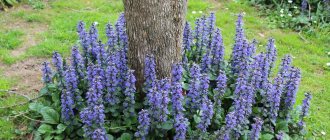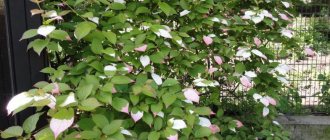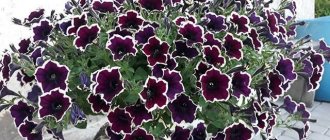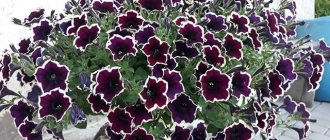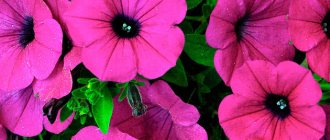In the fall, the garden prepares for the coming winter, with many plants shedding their leaves and preparing to enter a state of dormancy. However, some species will help make our garden bright and beautiful even in late autumn. Find out what flowers bloom in autumn (September, October).
In October, autumn fully comes into its own. The leaves of trees and shrubs change colors and fall off. Fortunately, the garden is not so gloomy when it comes to flowering plants. In October, some annual and biennial plants, bulbous and tuberous plants and perennials bloom. Below are the most beautiful flowers blooming in autumn with photos and names. Meet the most popular autumn flowers.
Types of autumn flowers
Autumn flowers delight the eye with bright colors. Their distinctive feature is a long flowering period. Many of them continue to bloom until October, and some retain buds until the first frost. Crops are classified according to height, decorative properties, and flowering time. But the basic scientific division of species is:
- perennial;
- annuals.
Having an idea of the characteristics and distinctive features of autumn plants, you can create beautiful flower beds with unusual combinations, assemble compositions according to shades or flowering dates. A properly organized garden is a place where every flower feels comfortable; for this you need to take into account the height of the plants and their characteristics. Low species should not be in the shadow of tall ones.
According to the timing of flowering, autumn plants are divided into:
- September;
- October;
- November
Features of use in landscape design
Many plants that bloom in autumn have no decorative value in the rest of the year, while others, on the contrary, are beautiful from spring until the onset of cold weather. When planning a flower garden or any other composition, this must be taken into account.
It should also be remembered that perennials tend to grow significantly.
Compositions
Autumn flora representatives are often used in continuous flowering beds. Low-growing cereals, chrysanthemums, asters and colchicums are perfect for these purposes. There is a place for autumn flowers on alpine slides.
Large sizes look great alone or in small groups. Beautifully flowering specimens look interesting against the background of taller cereals or a mixture of cereals of different types.
Autumn-flowering species, along with others, decorate lawns and the banks of reservoirs; tall ones are planted along fences or outbuildings.
Whatever the composition is conceived, it is important to select plants with similar requirements for soil, watering and lighting. You can find out which flowers need to be planted in the fall here.
September flowers
The weather in September most often resembles the end of summer. But in the second half of this month it usually gets colder. The last summer crops are blooming in the flower beds. But there are many plants for which September is the period when the first buds bloom. Some of them are especially popular among gardeners.
Chrysanthemums
Chrysanthemums, also known as oaks, boast a large variety of varieties. There are tall ones (up to 1.5 m), there are medium ones and very small ones that do not grow above half a meter. They also differ in color and splendor of buds.
Varieties with large flowers bloom in August and continue to bloom until November. But at the same time, they are very sensitive to cold, and varieties with small buds, on the contrary, tolerate winter well.
Korean oak trees, blooming with an abundant scattering of small stars, have become very popular, as well as varieties:
- Alyonushka - with simple bright pink buds;
- Altgold - a lush bud, in the form of a dark yellow pompom;
- Snow White - blooms with double white flowers;
- Hebe - simple yellow-pink inflorescences, blooms until frost;
- Lada - has fluffy lilac-pink flowers;
- Summer - large red inflorescences;
- Sunset Orange has large brown-orange flowers.
Depending on the variety, chrysanthemum leaves also vary in shape and size.
Asters
They have won the love of gardeners because of their long and abundant flowering. There are many varieties that begin to bloom in early autumn, for which people are sometimes called “Septembers” and “Octobers” (most often when it comes to New Belgian and New England varieties). There are a huge number of varieties of asters, differing in the splendor and height of the bush, and the shades of the flowers.
Asters belong to the genus of herbaceous plants; they are unpretentious in care. They are chosen because they reproduce easily, are not afraid of frost and bloom profusely right up to winter. Sometimes there are so many flowers on a bush that neither the stem nor the foliage of the plant is visible underneath them. There are both annual and perennial varieties.
Dahlias
Serve as a wonderful garden decoration. They are not afraid of shade, they can grow on soil with any composition, they need regular watering, but without waterlogging. Dahlias are divided into 6 main varieties:
- anemoid;
- peony-shaped;
- needle-shaped;
- collar;
- nymphaeal;
- spherical.
Their main differences are the size, shape, and splendor of the flowers, which can reach 12 cm. About 20 thousand varieties of dahlias have already been bred. These are plants that love warmth, so, as a rule, their flowering ends with the onset of the first cold weather; even slight frosts are destructive for them. For the winter, you need to create shelter for these flowers, otherwise the tubers may die.
Dahlias look beautiful in bright compositions against the background of a lawn, and also as design elements for paths.
Rudbeckia hairy
These are beautiful flowers of bright yellow or orange with a dark center. Outwardly, they are very similar to chamomile. This plant has a straight, elastic stem, about 6 cm high, and thick leaves with a rough surface.
Rudbeckia continues to bloom until frost and prefers soil rich in microelements (therefore it is important to fertilize periodically). The plant has no special care requirements, with the exception of regular watering. The culture looks great in combination with coniferous shrubs, in rockeries and just on lawns.
Zinnia graceful
Another name for this well-known culture among gardeners is “majors” or “majoriki”. It has an erect, strong stem covered with hard fluff. Flowers can vary in shade, as well as shape and volume, depending on the variety. The maximum bud size is 10 cm.
Zinnias prefer to grow in nutrient-rich soil, in an area with plenty of sunlight and protected from wind and drafts. These autumn flowers are used to decorate flower beds, balconies, ridges and mixborders.
Helenium autumn
A bush with helenium looks like fireworks of various shades, because this plant blooms with numerous and bright buds. Tall plants look like a ready-made bouquet; they can decorate any garden plot. Flowering continues until the first frost, attracting bees with its aroma. These crops are planted at the end of April or at the beginning of May, when it is no longer so cold at night. They winter well, but need shelter.
goldenrod
A perennial plant with a woody taproot. Its shoots are straight, covered with dense oval, slightly elongated foliage. It can reach a height of 0.3 to 1 m. The central stem is green, occasionally interspersed with a red or purple tint near the roots.
The leaves are pointed and toothed. The entire surface of the plant is covered with barely noticeable fluff. Small flowers are collected in large paniculate bright yellow inflorescences. Leaves are located between them. Blooms from May to September. This culture is not afraid of either drought or frost.
Goldenrod is a poisonous plant, so it is important to be careful when working with it.
Crocus
Crocus is a flower from the Iris family. Depending on the species, flowering occurs in spring or autumn. Perennial varieties are considered an autumn variety. The leaves of the crop are narrow, straight, dark green in color with white longitudinal stripes in the middle. The shape of the bud is something between a bell and a funnel.
The flower is formed by six petals placed in two rows - three large on the outside and three small on the inside. Each plant has one flower. A scattering of blossoming crocus buds resembles stars. Blooms for two weeks in September.
Monarda
A herbaceous plant native to North America. There are about 20 varieties of monarda. It can be annual or perennial. It has a straight branched stem and can reach 1.5 m in height. The leaves are elongated, pointed at the ends, with teeth on the sides, of a rich green hue. The plant itself has a pleasant mint-lemon scent.
Monarda can be used for cooking and aromatic drinks.
Flowering occurs from June to September. Buds up to 7 cm in diameter are collected in racemose inflorescences. When viewed from a distance, the flowers resemble a spider in shape. They can be yellow, white, red, purple and pink.
Gladiolus
A perennial plant with a corm-like root system. It is dug up for the winter to prevent hypothermia. The leaves of this flower are straight, sword-shaped. The stem with peduncle can reach 1.5 m in height. The inflorescence is spike-shaped, collected from one or two rows of buds. One plant can have up to 23 funnel-shaped flowers of various shades.
Ageratum
The plant is popularly called “long-flowered” for its long flowering period. It continues until the onset of severe frosts. The most popular variety among gardeners is Mexican Ageratum. This is a low crop, no more than 60 cm high, with small baskets of flowers collected in 7 cm inflorescences. Petals come in white, pink, blue and purple shades.
This plant prefers warm and sunny places; development stops in the shade. Frosts are destructive for young shoots. To extend the flowering period, you should promptly remove dried inflorescences along with the tip of the shoot.
Kobeya
This is a tall liana-like plant with tendrils, which in natural conditions serve as a kind of hook, with which the kobei clings to the bushes. The antennae are located near the beginning of the leaves. The inflorescences are small, up to 5 cm in diameter. The most common kobeya is found with white and purple flowers.
The liana is grown as an annual, as it does not tolerate frost. This is an unpretentious plant that grows and thrives well in any type of soil. Some varieties of kobei at the beginning of flowering have light flowers with a musky aroma, over time they darken and change the smell to a pleasant honey.
Lupine
Beautiful flowering perennial. It begins to bloom in July and ends with the first frost. Grows well in loose soil, with sufficient moisture and light levels. But it can also grow in shaded places.
This is a tall flower, the length of the stem reaches 1.2 m. The stem is straight, on it there are palmate foliage, and at its top there are racemose inflorescences up to 30 cm long. To extend the flowering period of lupine, you need to promptly remove dried buds. Crops are often used to decorate a site. A significant advantage is that they can stand in vases for a long time after cutting.
Lily Henry
Hybrid perennial plant with many flowers. One inflorescence reaches a diameter of 8 cm. The buds are turban-shaped and can grow to the side or upward. The petals are orange with dark red grooves. It begins to bloom in early August and ends at the end of September.
In favorable conditions it grows up to 1.5 m. This variety of lily can grow in a shaded place, but it will be more comfortable in the sun. Prefers slightly acidic or neutral soils. This is an unpretentious crop that tolerates frost well. Among the advantages is resistance to fungal diseases. In the first year, a young plant definitely needs shelter for the winter. It reproduces with the help of bulbous scales and baby bulbs.
Interesting article about water lilies. Read.
Balsam
An annual plant, popularly nicknamed “touch-me-not”. There are spherical, pyramidal and creeping species. It does not grow more than 75 cm in height. The stems are green and smooth. The shoots are very soft and tender with a reddish coating. The leaves are pointed, with small teeth along the edges.
There are species with orange, red and pink flowers. The seeds ripen in a box that opens at any touch. Impatiens prefers to grow in warm places, so young seedlings are planted at the end of May. It begins to bloom in July and ends with the first frost.
About autumn
According to the calendar, autumn begins on September 1; for astronomers, it comes on the day of the autumnal equinox (September 22). For meteorologists, this is the date of transition of the stable average daily temperature through 10 degrees to the lowest temperatures.
For phenologists (scientists who study the periodicity of phenomena in the life of animals and plants), autumn begins at the moment of noticeable yellowing of leaves on bushes and trees. Each year this time falls on a different date. Birch leaves usually turn yellow first, followed in order by linden, bird cherry, rowan, maple, and viburnum.
Autumn herbs and flowers retain their summer green color longer, although among them there are many plants with yellowed leaves and stems, but many are still blooming. Among the latter, some of the plants bloom again only occasionally, but there are those for which repeated flowering has become quite common.
After a warm and green summer, it's time for a cool but golden autumn. Gradually, all the trees and bushes are dressed in crimson and gold, cranes and other migratory birds scream in the transparent sky. It is not for nothing that A.S. Pushkin called this time “the charm of the eyes.”
October flowers
In October it is already significantly colder, which is why many garden plants do not delight with bright flowers. But even for this month there are a lot of autumn plants that help prolong the feeling of summer. Among the October species there are special specimens that are distinguished by their original beauty.
Snapdragon
Another name is “dogs”. Their individual small flowers look like an open lion's mouth, which is the reason for such an unusual name. These flowers come in a wide range of shades (from delicate white to dark burgundy). There are tall varieties (up to 80 cm), medium, low and dwarf varieties (no more than 20 cm in height). The inflorescences are located on a straight, strong, cap-shaped stem. The crops stop blooming with the onset of the first frost.
Loamy soil in free, well-lit areas is considered the most favorable for this plant. This is an absolutely unpretentious look. And with regular pruning of dried inflorescences, new lateral shoots with an abundance of colorful flowers develop. Snapdragons are used to decorate paths, flower beds, mixborders and ridges. The most popular varieties:
- Lemonade - lemon yellow color;
- Vulcan - bright orange;
- Diamond Rose - deep pink;
- Sharlah Triumph - fiery orange;
- Schwartz Prince - purple-black;
- Defiance - red;
- Schneeflex - white;
- Dunkel Garnet - combines dark purple and velvet colors.
Colchicum
The second name is colchicum. Begins to bloom in late autumn. However, its delicate flowers are reminiscent of spring. Grows no more than 20 cm in height. It does not require special care. Glades planted with colchicum beckon with their exquisite sophistication.
There are about 70 varieties of this flower. It prefers to grow in loose soil on the south side of the site. Loves the sun. Great for decorating rock gardens. Despite all its attractiveness and low maintenance requirements, colchicum is a poisonous plant that needs to be handled with caution.
Viola or Vitrocca violet
Better known as Pansy. This is a perennial frost-resistant plant with a height of 15 to 30 cm. The shape of the flowers is very similar to a violet. It is not afraid of shade, but in low light it does not bloom very profusely. There are many varieties of different shades.
Pansies prefer to grow in loamy soil and react negatively to waterlogging. Violas look great as decorations for balconies, borders, and large outdoor flowerpots. Sometimes they are planted in large numbers near trees.
Nasturtium
A popular garden plant found in many areas. Prefers to grow in moderately nutritious soil. In saturated fertile soil there is an active growth of green mass and flowering decreases, and in poor soil the decorative appearance is lost. Most nasturtiums are annuals.
There are 5 main varieties of nasturtium:
- bush - low annual bushes, not exceeding 30 cm, suitable for decorating borders, flowerpots, and look beautiful in landscape design;
- climbing - perennial, most often growing in flower beds, used to decorate gazebos and terraces;
- climbing - annual, suitable for decorating balconies, fences, walls, and hedges;
- terry - annual, optimal for landscape design;
- ampelous - an annual plant used for landscaping and decorating buildings.
Nasturtium bushes can be small, from 25 cm high, or large, up to 3 m. They prefer to grow in brightly lit areas. More than 90 varieties have been bred. There is even a frost-resistant variety that can withstand temperatures of -20 degrees, this is Nasturtium Multifolia.
Saxifrage
These are small flowers that look great on rocky areas and alpine hills. They begin to bloom in late September - early October. Grows well in the shade in moist, nutritious soil.
The flowers are small, somewhat reminiscent of bells, and come in different shades. They can be bright white, soft pink, yellow, rich red or crimson. In areas with very cold climates, saxifrages are grown as annual plants, since at temperatures below 6 degrees the flower begins to gradually die.
Saxifraga, which grows high in the mountains, is capable of releasing lime on the outside of its leaves. This helps the plant retain moisture.
Tricitris
A perennial herbaceous plant native to Japan. People often call it a garden orchid or toad lily. There are about 20 species. The height of the bush can reach 90 cm, the stems are straight, cylindrical. The rhizome is located near the surface. The culture has the ability to quickly recover from damage. The leaves are large, elongated, covered with red or pinkish dots. The buds resemble an orchid.
Flowers, the diameter of which does not exceed 4 cm, are located in the leaf axils. There are species with cream, lilac, yellow, and pink colors. Blooming tricitris in the autumn garden looks truly fascinating. Blooms from June until the first cold weather. Due to late flowering, plants often suffer from frost.
Mirabilis
The popular name for the flower is “night beauty”, due to the fact that the buds bloom at sunset and close by morning. This is an annual plant that blooms until October. Mirabilis prefers sunny areas and fertile soil.
Mirabilis has a branching stem up to 70 cm high. The leaves are pointed, reminiscent of lilac. Inflorescences of various colors (pink, white, orange and red varieties are found) bloom on a peduncle. Sometimes flowers of different shades appear on one plant.
Verbena
This is a popular garden plant. There are both annual and perennial varieties. There are different colors of buds: dark blue, burgundy and red. But they all have one thing in common - the white core of the flower. Verbena prefers to grow in a warm place. Young shoots are planted in loose soil at a certain distance from each other. This culture is ideal for decorating paths, flower beds, flower beds and borders.
Osteospermum
This is an annual or perennial herbaceous plant that is not afraid of cold weather. Blooms profusely throughout the season until early November. It has a strong, erect stem about 55 cm high, at the top of which there are large chamomile-like flowers.
This species is not afraid of either frost or heat. It easily tolerates sudden temperature changes and difficult weather conditions. Large inflorescences come in different shades: white, yellow, orange and purple. The flower grows best in fertile soil.
Sedum prominent
Sedum prominent (there are other names - sedum, hare cabbage, sedum squeak) is a perennial plant that can be found in a variety of places: in flower beds, at entrances, along paths.
The plant is absolutely unpretentious to growing conditions, so it feels great even in not the most favorable conditions. The only thing that sedum needs for beautiful flowering is a sunny area without stagnant water. The height of low-growing varieties (Brilliant, Matrona) of prominent sedum is 20-25 cm, tall varieties (Karl, Purple Emperor) are up to 60 cm. It grows as a compact bush. At the end of the season, the shoots die off at ground level (they must be removed), and in the spring they reappear from dormant buds. Sedum blooms in late summer - early autumn. Flowering lasts until frost. When cut, the plant can stand for 1.5-2 months if you regularly change the water in the vase and trim the ends of the stems.
November flowers
In November, the garden looks empty - the trees have already lost their leaves, most of the plants are preparing for hibernation. But the same autumn flowers can add color to the area, continuing to bloom until frost, filling the cold air with a warm summer aroma.
Marigold
The second name is tagetis. Marigolds are both perennial and annual. These are flowers that resemble rays of the sun with their picturesque range of shades - from bright yellow to reddish brown. There are more than 50 varieties of this crop. They fill the garden with a wonderful aroma that cannot be confused with anything else. They grow in small bushes from 20 cm to 1 m in height.
Flowering continues until frost. They are classified into several types, depending on the shape of the inflorescences:
- simple;
- terry;
- semi-double;
- chrysanthemum-shaped;
- Dianthus.
Hybrid varieties are the most popular among gardeners.
Petunia
These flowers are also annual and perennial. There are about 20 varieties in total. They tolerate any weather conditions well and do not require a special soil composition, which is why they are popular with many gardeners.
There are petunias with a creeping stem, the height of which is no more than 10 cm, and with an erect one. This plant can decorate a summer cottage even in late autumn, thanks to its rich color palette. Petunia is used to decorate flowerpots, flower beds, and paths.
Rhododendron
Belongs to the genus of evergreen plants. It begins to bloom in June, but its dark green foliage can liven up the cold autumn landscape of November. The variety most resistant to winter frosts is Katevbinsky Grandiflorum.
This crop has lush green foliage and grows up to 4 m. An unpretentious plant, fast-growing (up to 12 cm per year), and also resilient (the average lifespan of rhododendron is 100 years), which makes it a unique find for amateur gardeners. Grows best in slightly acidic, peaty, loamy or acidic soil.
Read “what is peat“
Phloxes
Colorful flowers with an extraordinary aroma. They bloom profusely with large lush inflorescences. Late-flowering variety - paniculata phlox. This is a tall bushy plant with bright buds - from pale pink to bright scarlet and purple shades, you can find species with a striped pattern.
Popular varieties:
- Cloud;
- Andre;
- Vladimir;
- Creme de Menthe;
- Anna with snow-white flowers;
- Bronimer Nasummer - soft pink;
- New - white and blue;
- Margry - tricolor.
Rose
Rose has rightfully earned the title of queen of flowers. There are cold-resistant varieties that continue to delight the eye even after the first frost. Many varieties of roses have been developed that can withstand harsh winters and bloom until December.
Interesting! An unusual species is Rosa Rugosa. Be sure to read it.
Most often, park and selection Canadian and American crops have these characteristics. The choice of varieties of rose bushes of different colors and types is so huge that every gardener will find a plant to his liking.
Poskonnik
This is a plant with a straight stem up to 2 meters high. At the tops of the shoots there are large corymbose inflorescences up to 25 cm in diameter. The leaves are large, elongated, located along the entire stem. The flowers themselves are small and come in different colors: from snow-white to purple.
During the flowering period, the sapling exudes a pleasant, unobtrusive aroma. The Purple variety is the most popular in the central zone. It became popular for its long flowering period - from July until the first frost. This plant is often used in folk medicine because of its anti-inflammatory and healing effects.
Autumn flowers are distinguished by their diversity and extraordinary beauty. Any flower that continues to bloom or just blooms during the period when nature is preparing for winter sleep pleases the eye and gives a charge of positive emotions and a feeling of special summer energy.
Elder
The plant is a bush or small tree with a height of 2 to 6 meters. In our climate, the black elderberry (“Black Tower”) looks most impressive - with large leaves and fragrant flowers. In autumn, it is decorated with black berry-shaped fruits, and the purple leaves turn red-brown.
Irga
Tall shrub reaching 3–4 meters in height. Irga is unpretentious and grows successfully on any soil. The plant pleases not only with lush flowering in the spring, but also with delicious berries in the summer. And when autumn comes, the leaves of the serviceberry turn red, sometimes even burgundy.
Bladderwort viburnum
An ornamental shrub with spreading branches that fall beautifully to the ground. Dimensions usually do not exceed 3 meters in height. And thanks to the variety of varieties, every summer resident can find a suitable one, for example, the “Amber” variety turns crimson in autumn, and “Diablo” retains the purple color of its leaves in summer and autumn.
Work before wintering
Overgrown bushes should be replanted. Carefully examine the root system and bulbs, removing weak and diseased parts. Dry the rhizomes and bulbs of gladioli, peonies and dahlias and store in a cool place. Apply fertilizers containing phosphorus and potassium to plants that do not require replanting. The ground under the bushes needs to be dug up. Carefully trim and cover the roses. In early September, plant tulips and daffodils. Collect seed material for the next season from annuals. Cover climbing perennials with your own shoots. Sprinkle the soil around the peonies with sand and ash, and cut off the greenery. You can cover it when frost starts.
Marigold
The Latin name of this plant is Tagetes, so it was named in honor of Tagetus, the grandson of Jupiter and the son of Genius. He became famous for his ability to predict the future. The boy had high intelligence and a unique gift of foresight. He appeared to people in the form of a baby who was found in a furrow by a plowman. The kid taught people to tell fortunes using the insides of animals, and also told them what would happen next in the world. He disappeared just as he appeared, completely suddenly. His predictions were recorded in prophetic books and passed on to their descendants.
Bodinier's beautiful fruit
The spreading shrub paints the garden palette with purple colors with the help of many small purple-lilac berries. The bush reaches a height of 1.5 to 3 meters, has long dark green leaves and is therefore not noticeable in summer. But in the second half of September, the beautiful fruit plant pleases with its unusual appearance, and the berries remain on the branches until winter.
Forsythia
Flowering begins in early spring: the branches of the bush are showered with lemon-yellow flowers, attracting attention. Forsythia is often used as an addition to flower beds and landscape compositions. It pleases with its colorfulness not only in spring, but also in September, when the foliage acquires a bright golden color.
Aster
Its homeland is Northern Asia. Aster is a plant of autumn flower beds. Beliefs and legends associated with it are passed down from generation to generation. Here are some of them.
Five centuries ago, a botanist from France came across the seeds of an unknown plant. He sowed them, and a wonderful red flower with a yellow center blossomed. It was similar in appearance to a daisy, only larger. That’s what they called him – “Queen of Daisies.” Gardeners began breeding new varieties, and, after some time, they got a beautiful flower with double petals. One of the nerds shouted: “Aster!” Translated from Greek it means “star”. This is how the flower got its name “aster”. Annuals are especially popular among gardeners thanks to the efforts of breeders from France.
According to another belief, the flower received this name due to its thin petals reminiscent of star rays. If you go out into the garden where asters grow at midnight and stand between them, you can hear their quiet whispering. This is how they communicate with the stars. The constellation Virgo is always associated with Aphrodite, the goddess of love. According to ancient Greek legend, when the Virgin cried and looked at the earth, an aster was formed from fine cosmic dust. This flower is considered a symbol of the fair sex, who were born under the sign of Virgo. For the ancient Greeks, it means a wonderful feeling - love. Charm, elegance, modesty, beauty and precision - in China. In Hungary, the aster is the rose of the golden season and an ideal plant for the autumn flower garden. The belief about her is as follows. Several centuries ago, people believed that smoke from a fire into which aster petals were thrown would drive away snakes.
Zinnia
One of the most famous and many beloved crops among gardeners around the world. This name was given to it by K. Linnaeus in honor of Professor Zinn, who headed the botanical garden in Gotting. This flower was first discovered in the gardens of the Aztec ruler Montezuma by the Spaniards. The stem of different varieties differs in height and can reach one meter. Blooms until frost. Sunny places are preferable for growing. It has a huge variety of colors - almost all shades, with the exception of blue. In the USA, zinnia is the national flower.
Gladioli
Africa is considered the birthplace of the flower; in this country it symbolizes happiness. In Rome and Ancient Greece it is a symbol of gladiators, as it is shaped like a sword. Healers and shamans attributed magical properties to it. Gladiolus is an autumn flower garden plant. Beliefs and legends say that in ancient times in South Africa, when wars were commonplace, invaders descended on a small village. The elder disappeared, hiding all the values of the community from enemies. But they captured his daughter and tortured her, trying to find out where her father was hiding. The girl did not utter a word, and then the strangers decided to execute her in front of the entire community. As soon as the sword touched the girl’s neck, it suddenly turned into a flower with blood-red buds. The enemies got scared and decided that it was the gods who were condemning them, and quickly ran away, saving the young girl’s life.
There are other legends about the origin of this wonderful flower. Here is one of the beliefs. An autumn flower garden plant, gladiolus roots, hung on a warrior’s chest as an amulet, will save him from death and help him win a battle. In the Middle Ages, German infantrymen believed in the magical power of bulbs and wore them as amulets.
Gladiolus requires fertile soil, abundant infrequent watering and a lot of light. After flowering, the green part of the plant is cut off, and the bulb is left to ripen for up to two weeks. Then it is dug up, dried and stored in the refrigerator until spring. Thrips are the main enemies. They hide in the bulbs; to combat them during the growing season, the plant is sprayed with fungicidal agents. They reproduce by daughter bulbs, or they are also called babies.
Reviews from gardeners
Aster is a very beautiful flower. It blooms almost until frost. Who would have thought that it has about 200 varieties, many different shades and shapes. There are flowers similar to chamomile, only there are many more petals. There are also completely unusual ones - with curls and stars along the edges of the petals. It turns out that asters in China are considered a symbol of beauty, charm and modesty. From this country they came to Russia.
Tamara, 27 years old
September. I love this time: the stingy rays of the sun, the occasional drizzling rain and the last flowers in the city flower beds. There are already a few of them, but they please the eye and cheer the soul - autumn flowers, different names. In September, chrysanthemums, dahlias, asters, and marigolds delight the eye. Thank God for creating such beauty.
Olga, 32 years old
Last summer my husband and I bought a dacha. There are forests all around and a river nearby where you can swim and fish. And what freedom for children: run wherever you want, berries are right under your feet, and closer to autumn there will be mushrooms, which we collect with the whole family. But most of all I rejoice in the fact that I can plant a sea of flowers. I read on the Internet which plants bloom in the fall. I prefer dahlias, blue daisies, asters, gladioli. I plant fall-flowering perennials. I try to organize flower beds so that some plants fade while others begin to bloom.
When it's wet and cold outside, flowers bring joy to the heart.
I have one large flower bed and there are 10 different species in it. In the very center I planted an aster, around it - ageratum, then pink mallow and dwarf asters in bushes. The flowerbed is square, with multi-colored dahlias growing along the entire perimeter. This flower garden makes us happy until the snow. Valentina, 46 years old
